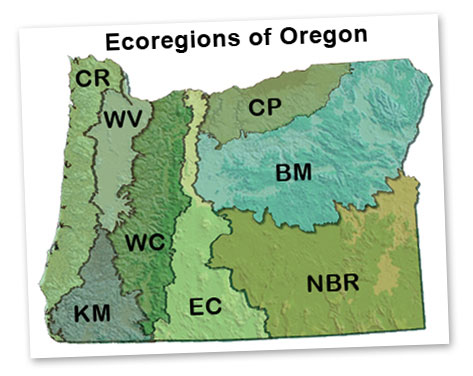 INSTITUTE FOR NATURAL RESOURCES
INSTITUTE FOR NATURAL RESOURCESYou are here
Biodiversity
Landscapes and Ecosystems
- Intro
- Planning Resources
- Research Projects
- Articles & Stories
- Maps & Tools
- Reports & Publications
- Data
- Photos & Videos
- More
Conservation Strategy Habitats and Ecosystems
Strategy Habitats, as defined by the Oregon Conservation Strategy were determined by comparing maps of current vegetation to maps of vegetation in 1850 in order to determine vegetation types that had high degrees of loss since European settlement. Vegetation types with a high degree of loss were evaluated for historic importance at the ecoregional scale, ecological similarity, amount of remaining habitat managed for conservation values, known limiting factors, ecological similarity and importance to Strategy Species.
Strategy Habitats provides general descriptions, conservation overviews, issues and recommended approaches for habitat conservation. These are intended to be broad views of Strategy Habitats from a statewide perspective. Conditions will vary on the site, watershed, and ecoregional level based on differences in soil, climate, and management history. Local conditions will need to be considered when determining site-appropriate conservation actions.

ODFW, edited by John Ame
The number of Strategy Habitats per ecoregion range from four in the Columbia Plateau to seven in the Coast Range. Aquatic, riparian and wetlands were identified as Strategy Habitats for all eight ecoregions. Other common Strategy Habitats occurring in more than one ecoregion include grasslands, oak, ponderosa pine and sagebrush habitats. Strategy Habitats that occur in more than one ecoregion are usually affected by similar limiting factors, such as invasive species, conversion to other land uses, or altered disturbance regimes, particularly vegetation changes due to fire suppression.
The ecoregions used in Strategy Habitats are:
- BM = Blue Mountains
- CP = Columbia Plateau
- CR = Coast Range
- EC = East Cascades
- KM = Klamath Mountains
- NBR = Northern Basin and Range
- WC = West Cascades
- WV = Willamette Valley
Strategy Habitats and Ecosystems:
- Aspen woodlands habitat
- Coastal dunes habitat
- Estuaries habitat
- Riparian habitats and flowing water habitat
- Grasslands habitat
- Late successional mixed conifer forest habitat
- Natural lakes habitat
- Oak woodlands habitat
- Ponderosa pine woodland habitat
- Sagebrush habitat
- Wetlands habitat










